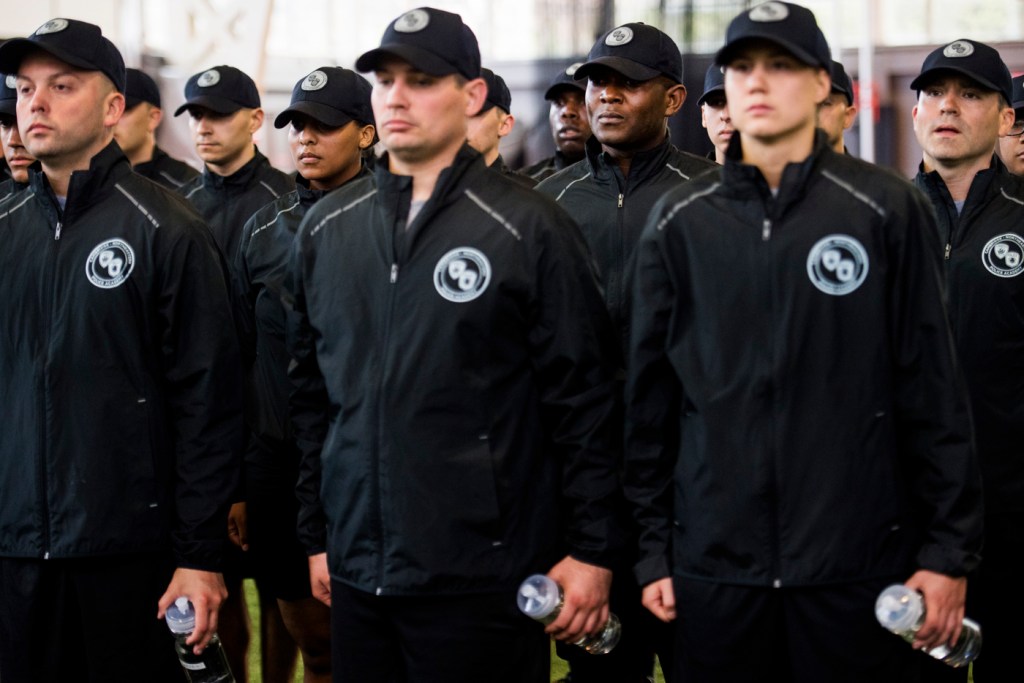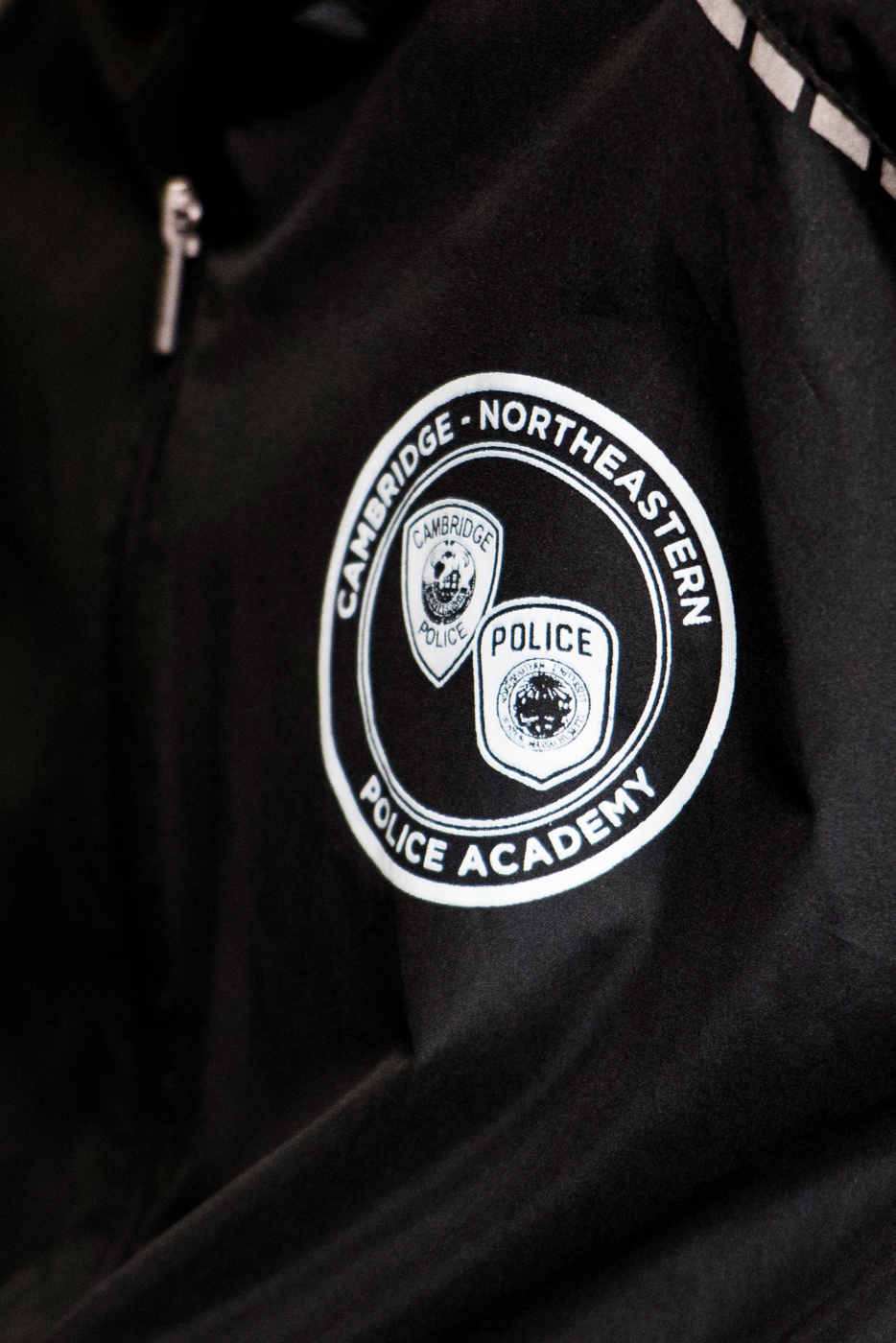The new Cambridge-Northeastern Police Academy is leading an ‘evolution of the profession’ of law enforcement

In a West Village classroom on the Boston campus, three Northeastern students were locked in a volatile altercation. Police officers were called forward in pairs, one team after another, to take their turn at defusing the crisis.
The students were actors, hired to bring authenticity to the scenario. The officers were recruits, who were being evaluated in terms of their empathy, the distance they maintained from the subjects, and other guidelines.
It was part of their training at the Cambridge-Northeastern Police Academy—a groundbreaking joint venture between the police departments of Northeastern University and the city of Cambridge, Massachusetts, that is designed to steer American law enforcement in a new direction, says Michael Davis, associate vice president and chief of police at Northeastern. Davis and Cambridge Police Commissioner Branville Bard were the drivers of the pilot program, which opened May 6.
Northeastern is the only research university in New England to run a police academy, says Davis, who adds that instructors are using the urban setting on the Boston campus to ensure that officers training at Northeastern connect with the public far more often than at traditional academies. Davis says that the increased exposure to the public will result in better policing down the line.
“We realized that our profession has been stuck in this rut for the last 30 to 40 years, with no real change, no evolution,” says Ruben Galindo, Northeastern’s director of public safety and deputy chief of police. “So we thought it was time to make a statement. It’s time to start what we hope is an evolution of the profession, if not a revolution at some point.”



The academy serves as Northeastern’s creative response to the pressures that are faced by American police externally and internally. While 52 officers in the United States were shot and killed last year—a 12 percent increase, according to The National Law Enforcement Officers Memorial Fund—the number pales in comparison to police suicide: The nonprofit group Blue H.E.L.P. reported that at least 159 officers killed themselves in 2018, marking the third straight year that suicides exceeded line-of-duty deaths.
“We’re one of the few professions that screens for mental health,” Galindo says. “We should have one of the lowest rates of suicide, yet the opposite occurs.”
A commitment to equality
A failure to modernize American law enforcement has created stress within police departments, resulting in controversial citizen deaths—according to a Gallup poll, only 30 percent of African-Americans have confidence in police—as well as tension among officers that is unsustainable, according to Davis.
“The last few years have been tough for the profession of law enforcement—going back to Ferguson, and these cases that have occurred across the nation,” Galindo says of the 2014 Missouri shooting by police of Michael Brown, an unarmed 18-year-old. “You can look at the [Department of Justice] report from Ferguson, it was systemic racism in that department. Then you add on the hostile work environments that exist in many police departments.”
The better way to connect with the public, says Davis, is to invest in a culture of egalitarianism and respect. After Davis arrived at Northeastern in 2013, he decided that all officers would wear similar uniforms and badges, which encouraged them to view each other as equals regardless of rank.
“Everyone wears the same color shirt, the same color badge, because that’s the same mentality we want carried out into the field—we don’t want cops treating people as though [the police] are better,” Davis says. “If you go into every conversation believing you have something to learn, then that is benefiting you as you are benefiting the person that you’re helping.”
The 28 student officers in the Academy, who include three women and range in age from 23 to 39, commute to campus each weekday at 6:30 a.m. for an hour of physical training at Carter Playground or Cabot Cage. The remainder of the day is spent in class, where Senior Staff Instructor Darin Cromwell of the Cambridge Police Department preaches a balance between traditional law enforcement and a constructive investment in the community.
When the 20-week program concludes in September, the graduating officers will join 13 municipal and university police departments across Massachusetts.
Davis and Bard share a similar point of view on the future of policing, which has been crucial to the Northeastern-Cambridge partnership, says Andrea Brown, chief of professional standards for the Cambridge Police Department.
“Where law enforcement is going is more in the direction of community engagement,” Brown says. “They’ve hit the ground running. You really wouldn’t know that [the academy] is brand new.”
The Cambridge-Northeastern academy is adhering to the guidelines of the state’s Municipal Police Training Committee—and interpreting the traditional rules in new ways.
“We have the standard curriculum, and you shouldn’t get away from that,” says Northeastern lieutenant Adam Keeling. “It’s the white space in between where you can make a difference.”
Innovation “is in the Northeastern DNA,” says Davis.
Meeting students on their terms
Northeastern’s combination of modern facilities in an urban setting is a difference-maker, Cromwell says. Typical police academies are sequestered from the general public, but the recruits at Northeastern have access to students, faculty, and staff of all ages and backgrounds. When they’ve earned the right, each of the trainees will be expected to introduce themselves to at least one student per week—to engage in casual conversation, and report back to the academy with the story of that student.
“They need to go out and engage with someone they’ve never met,” Galindo says. “Just walk around campus: ‘Sir, do you have a second? Let me introduce myself. Tell me a little bit about yourself, where are you from?’ And hopefully in that conversation they might even be able to help someone.
“You may have a student from China who has been here three weeks, and maybe he has no idea how to get in and out on the ‘T,’” Galindo says of Boston’s subway system. “Let’s take the train in and out, show him how to buy a ticket—that’s what makes you a great police officer. You found someone you had a conversation with, and you were able to help them with something.”
Police departments can no longer assume that officers are comfortable in dealing with the public, Keeling says.
“A newer generation of individuals that are coming out of police academies, many of them don’t have that interpersonal skill,” says Keeling, who oversees hiring at Northeastern’s police department. “They’re not as aware of their body language and how that body language translates when they’re on a call with people. They need to get to a point where they’re locked in and they understand their responsibilities.”
“Are you comfortable in striking up a conversation with a stranger?” Davis says. “Because if you need [the authority of] the uniform be able to do that, then forget it.”
Davis encourages his staff to focus on the people whom they have helped. Each night on campus, the midnight crew of Northeastern officers hands out bags of sandwiches and drinks to the homeless, with a card that details where to find help.
“We get a call for someone in the park who is about to inject heroin,” Galindo says. “There’s a difference between me approaching that call with my partner, saying, ‘Here we go, we have to deal with this junkie.’ Or, ‘We are about to engage with someone’s daughter who is in desperate need of help.’ Because that’s who they are, right?”
By training officers to seek out the potential in people, however, Davis and his officers believe that a new path for policing can be explored.
“I still remember my academy experience in vivid detail, it was such a poignant part of my life,” Keeling says. “Statistically speaking, there are probably four or five people in that classroom that are going to be in some sort of leadership position in their department, eventually. We have the ability to lay that foundation here for them, for when they have the opportunity to be in charge, to make a difference. These lessons can stay with them their whole life.”
For media inquiries, please contact Mike Woeste at m.woeste@northeastern.edu or 617-373-5718





